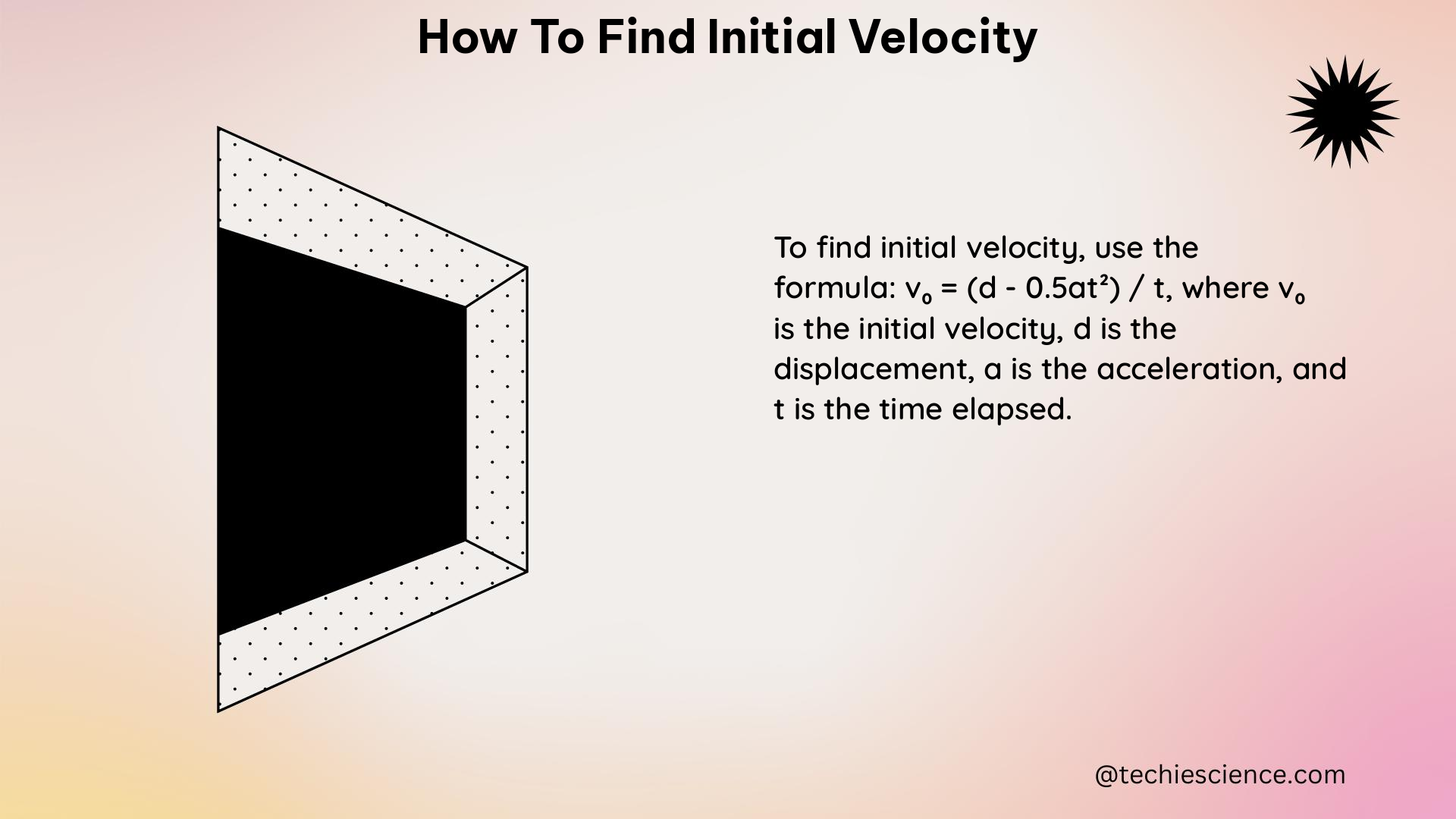Summary
Initial velocity is a crucial parameter in the study of motion and is used to determine the behavior of an object over time. This comprehensive guide will provide you with a detailed understanding of the various methods and formulas used to calculate the initial velocity of an object, along with relevant examples and problem-solving techniques.
Table of Contents

- Using Final Velocity, Time, and Distance
- Using Final Velocity, Acceleration, and Time
- Using Distance, Acceleration, and Time
- Using Conservation of Energy Theorem
- Example Problems
- Additional Resources
1. Using Final Velocity, Time, and Distance
To find the initial velocity (V_i) using the final velocity (V_f), time (t), and distance (d), you can use the following formula:
V_i = 2(d/t) – V_f
This formula is derived from the equation of motion:
d = V_it + (1/2)a*t^2
Where:
– d is the distance
– t is the time
– a is the acceleration
– V_i and V_f are the initial and final velocities, respectively
If the acceleration is constant, you can rearrange the equation to find the initial velocity.
Example:
A car accelerates from rest to a final velocity of 60 km/h in 10 seconds, covering a distance of 150 meters. Calculate the initial velocity of the car.
Given:
– V_f = 60 km/h = 16.67 m/s
– t = 10 s
– d = 150 m
Substituting the values in the formula:
V_i = 2(d/t) – V_f
V_i = 2(150/10) – 16.67
V_i = 30 – 16.67
V_i = 13.33 m/s
Therefore, the initial velocity of the car is 13.33 m/s.
2. Using Final Velocity, Acceleration, and Time
To find the initial velocity (V_i) using the final velocity (V_f), acceleration (a), and time (t), you can use the following formula:
V_i = V_f – a*t
This formula is derived from the equation of motion:
V_f = V_i + a*t
Where:
– V_i and V_f are the initial and final velocities, respectively
– a is the acceleration
– t is the time
Example:
A ball is thrown upward with an initial velocity of 20 m/s. After 2 seconds, the ball has a final velocity of 10 m/s. Calculate the acceleration of the ball.
Given:
– V_i = 20 m/s
– V_f = 10 m/s
– t = 2 s
Substituting the values in the formula:
V_i = V_f – at
20 = 10 – a2
a = 5 m/s^2
Therefore, the acceleration of the ball is 5 m/s^2.
3. Using Distance, Acceleration, and Time
To find the initial velocity (V_i) using the distance (d), acceleration (a), and time (t), you can use the following formula:
V_i = (d/t) – (1/2)at
This formula is derived from the equation of motion:
d = V_it + (1/2)a*t^2
Where:
– d is the distance
– t is the time
– a is the acceleration
– V_i is the initial velocity
Example:
A ball is dropped from a height of 100 meters. After 2 seconds, the ball hits the ground. Calculate the initial velocity of the ball.
Given:
– d = 100 m
– t = 2 s
– a = -9.8 m/s^2 (acceleration due to gravity)
Substituting the values in the formula:
V_i = (d/t) – (1/2)at
V_i = (100/2) – (1/2)(-9.8)2
V_i = 50 – (-9.8)
V_i = 59.8 m/s
Therefore, the initial velocity of the ball is 59.8 m/s.
4. Using Conservation of Energy Theorem
The conservation of energy theorem can be used to find the initial velocity when the potential energy is converted into kinetic energy. The formula is:
V_i = sqrt(2gh)
Where:
– g is the acceleration due to gravity (9.8 m/s^2)
– h is the height
– V_i is the initial velocity
Example:
A ball is thrown vertically upward with an initial velocity of 20 m/s. It reaches a maximum height of 25 meters. Find the initial velocity of the ball.
Using the conservation of energy theorem, we can find the initial velocity as:
V_i = sqrt(2gh)
Where:
– g = 9.8 m/s^2
– h = 25 m
– V_i is the initial velocity
Substituting the values:
V_i = sqrt(29.825)
V_i = 22.1 m/s
Therefore, the initial velocity of the ball is 22.1 m/s.
5. Example Problems
-
A ball is thrown vertically upward with an initial velocity of 30 m/s. It reaches a maximum height of 45 meters. Find the initial velocity of the ball.
-
A car accelerates from rest to a final velocity of 80 km/h in 12 seconds, covering a distance of 200 meters. Calculate the initial velocity of the car.
-
A ball is dropped from a height of 120 meters. After 3 seconds, the ball hits the ground. Calculate the initial velocity of the ball.
-
A ball is thrown upward with an initial velocity of 25 m/s. After 4 seconds, the ball has a final velocity of 5 m/s. Calculate the acceleration of the ball.
6. Additional Resources
- How to calculate initial velocity – YouTube
- Using the Conservation of Energy Theorem to Find an Initial Velocity
- Initial Velocity Formula – Definition, Formula and Solved Examples
- 4 Ways to Find Initial Velocity – wikiHow
- IRIS | Page 7: Challenging, Ambitious, Measurable Annual Goals

The lambdageeks.com Core SME Team is a group of experienced subject matter experts from diverse scientific and technical fields including Physics, Chemistry, Technology,Electronics & Electrical Engineering, Automotive, Mechanical Engineering. Our team collaborates to create high-quality, well-researched articles on a wide range of science and technology topics for the lambdageeks.com website.
All Our Senior SME are having more than 7 Years of experience in the respective fields . They are either Working Industry Professionals or assocaited With different Universities. Refer Our Authors Page to get to know About our Core SMEs.